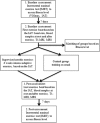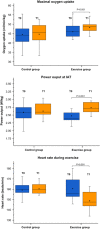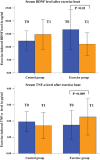Hippocampal structure, metabolism, and inflammatory response after a 6-week intense aerobic exercise in healthy young adults: a controlled trial
- PMID: 26082010
- PMCID: PMC4640322
- DOI: 10.1038/jcbfm.2015.125
Hippocampal structure, metabolism, and inflammatory response after a 6-week intense aerobic exercise in healthy young adults: a controlled trial
Abstract
Interventional studies suggest that changes in physical fitness affect brain function and structure. We studied the influence of high intensity physical exercise on hippocampal volume and metabolism in 17 young healthy male adults during a 6-week exercise program compared with matched controls. We further aimed to relate these changes to hypothesized changes in exercised-induced brain-derived neurotrophic factor (BDNF), interleukin-6 (IL-6), and tumor necrosis factor alpha (TNF-α). We show profound improvement of physical fitness in most subjects and a positive correlation between the degree of fitness improvement and increased BDNF levels. We unexpectedly observed an average volume decrease of about 2%, which was restricted to right hippocampal subfields CA2/3, subiculum, and dentate gyrus and which correlated with fitness improvement and increased BDNF levels negatively. This result indicates that mainly those subjects who did not benefit from the exercise program show decreased hippocampal volume, reduced BDNF levels, and increased TNF-α concentrations. While spectroscopy results do not indicate any neuronal loss (unchanged N-acetylaspartate levels) decreased glutamate-glutamine levels were observed in the right anterior hippocampus in the exercise group only. Responder characteristics need to be studied in more detail. Our results point to an important role of the inflammatory response after exercise on changes in hippocampal structure.
Figures





References
Publication types
MeSH terms
Substances
LinkOut - more resources
Full Text Sources
Other Literature Sources
Medical
Miscellaneous

